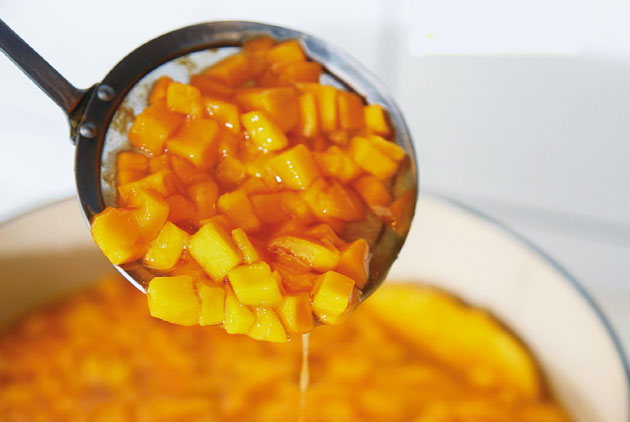Nara eateries get shot at fabled Michelin Guide
2011/05/31
 Kakinoha-zushi
Kakinoha-zushi Asuka nabe
Asuka nabe Chagayu porridge
Chagayu porridge Bernard Delmas, president of Nihon Michelin Tire Co., announces the addition of Nara Prefecture restaurants to the Kansai edition of Michelin Guide on April 13. (Wataru Kishigami)
Bernard Delmas, president of Nihon Michelin Tire Co., announces the addition of Nara Prefecture restaurants to the Kansai edition of Michelin Guide on April 13. (Wataru Kishigami)
While Nara Prefecture has long attracted tourists to its ancient capitals and historical sites, the food here has always been just an afterthought.
That could change in October, when the Kansai edition of the fabled Michelin Guide will include Nara Prefecture restaurants in its ratings for the first time.
Many Nara Prefecture residents and restaurateurs say they cannot wait to see how their local restaurants will stack up under the scrutiny of the world's top authority in the gourmet world.
Junichiro Horie, owner of the Italian restaurant Ristorante i-lunga in Nara's Kasugano district, said the prefecture's tourism has been characterized by a passive business approach targeting tourists who visit the Great Buddha in Todaji, Nara Prefecture.
"The Black Ship has finally arrived in Nara," Horie, 40, said, comparing the Michelin Guide to Commodore Matthew Perry's arrival in a Japanese port in 1853. "I hope the upcoming Michelin Guide will help revitalize the city."
According to the Michelin Guide secretariat, about 200 restaurants in Nara Prefecture had been tagged before the French editor in chief and seven Japanese inspectors started researching them last fall. It is not known if the new guide will cover restaurants in the prefecture or in Nara city.
The news had local restaurateurs searching their memories to see if any inspectors may have dined in their restaurants.
Rating restaurants is conducted by Michelin inspectors who go undercover as customers. Their identities and methods are secret.
In early April, Obana, a Japanese restaurant in Nara's Takahata town, had a middle-aged woman in a suit as a customer, owner Minoru Shindo said.
She ordered a "kaiseki" Japanese set course meal priced at 3,900 yen ($48.28). While dining, she took pictures of the dishes and asked questions such as "Where is this from?"
The level of her questioning was quite high, Shindo, 60, recalled.
"She was apparently not an ordinary customer," he said with great interest. "Maybe we were being graded."
Previously, a survey by the Nanto Economic Research Institute in 2003 found that Tokyo residents did not expect much of Nara food when they visited the city. Asked what they looked forward to in Nara, "food" ranked only 10th.
But an official said times have changed.
"Before, there may have been restaurants which offered tourists' dishes, thinking any which they were prepared was OK," said Miho Kakuyama, a marketing official of the prefecture. "But it is no longer so."
The prefecture has hosted the Nara Food Festival since 2009, inviting noted chefs from across the country and having them prepare dishes using ingredients produced in the prefecture, such as Yamato vegetables.
About 100,000 people showed up to the month-long event during the festival last fall. An event attended by local chefs also attracted many visitors.
"Nara Prefecture meets the standard as a candidate for the Michelin guidebook," Kakuyama said proudly.
On April 13, Bernard Delmas, president of Nihon Michelin Tire Co., was in Nara to announce that the prefecture would be added to the Michelin Guide's Kansai edition, and said at the news conference, "I enjoyed the 'chagayu' porridge I had for lunch."
That surprised Yoshinobu Hasegawa, a 69-year-old "minshuku" inn owner, who said he did not think chagayu was popular among foreigners.
Four to five groups of foreigners stay every month at his Hatago Hasegawa inn, known for its local specialties, and many are from France, where Michelin is based, but most of them do not even try chagayu, he said.
"Westerners are not familiar with rice gruel, and the yellow color may make them refrain from even trying it," he said.
According to Hasegawa, one popular dish among foreign guests is Asuka nabe, a traditional pot cooking method using a broth made from milk, soy bean paste and chicken.
He said since milk is an internationally common drink, it is liked by people from all over the world.
Hasegawa is circumspect about Michelin's upcoming book, saying, "While I am grateful that the guidebook appreciates our tradition, I am worried on what scale the high-end oriented Michelin will grade us."
Michelin's guide for the Kansai area, which was first published in 2009, has ignored Osaka's trademark regional specialities such as "takoyaki" (octopus balls) and "okonomiyaki" pancakes.
Yoshihisa Masui, deputy secretary-general of a Nara-based NPO to study food culture in Nara, said, "As far as I have read, the guidebooks have been edited under the supervision of foreigners. I have not come across any review that has insights into popular food culture."
(This article was written by Daizo Teramoto and Masaaki Yashiro.)
Chagayu
Content Number:20644

This traditional rice broth of the Kumano region has the flavor of tea. It is easy to digest, and known locally as "okaisan." In the cold winter people eat it hot, and in the summer, when it is hard to work up an appetite, it is eaten cold.






